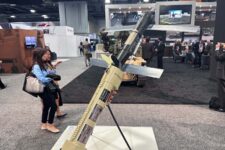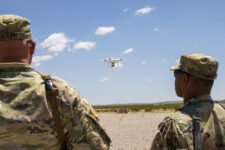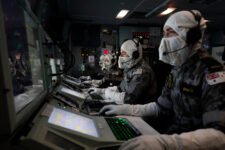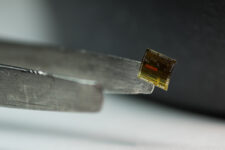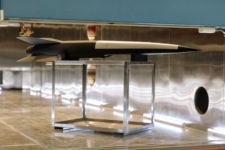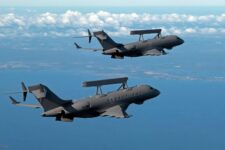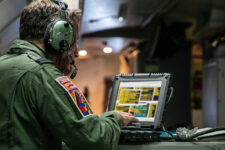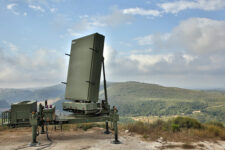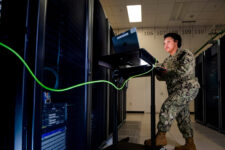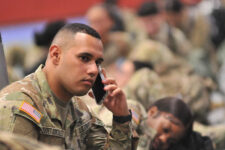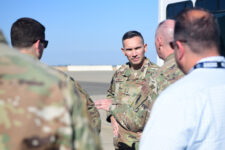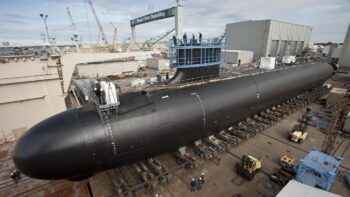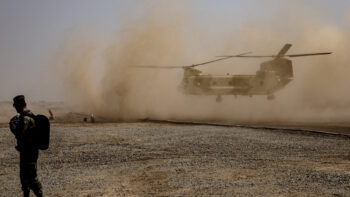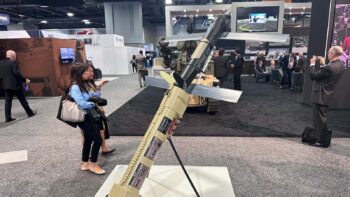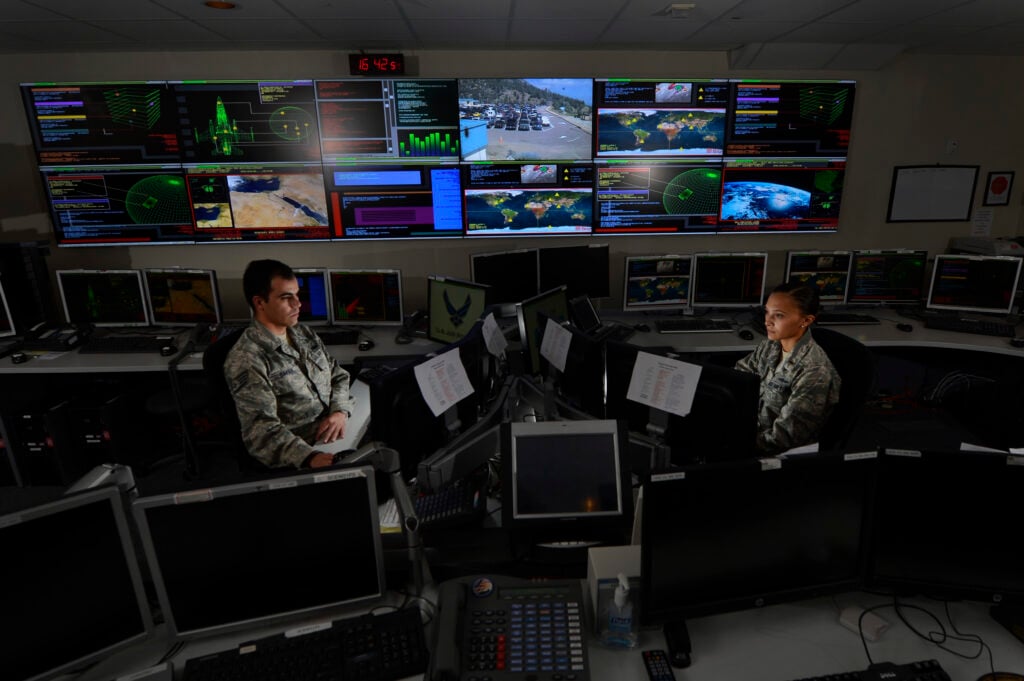
NORAD space operations center under Cheyenne Mountain
WASHINGTON: Northern Command is prototyping and testing a set of AI tools to support Joint All Domain Command and Control (JADC2) implementation, NORTHCOM officials tell Breaking Defense. Most importantly, they said, the new artificial intelligence will instantly pull together all sorts of data to give commanders a clear picture of the battlefield, enabling good, fast decisions.
The command is leading a virtual exercise, called the Global Information Dominance Exercise (GIDE) 2, March 18-23 to test three “decision aids” that use artificial intelligence/machine learning software to speed commanders’ ability to act, Col. Matt “Nomad” Strohmeyer, NORAD/USNORTHCOM J8 JADC2 Development Lead, explained in an exclusive interview. The AI algorithms will enable all-domain situational awareness, “information dominance,” and real-time “cross-Combatant Command collaboration,” he said.
The ultimate goal, Strohmeyer explained, is to transition the technology to the services for integration into acquisition programs to implement JADC2 and the emerging Joint Warfighting Strategy.
When asked why NORAD and NORTHCOM have been leading this charge, he stated, “we just happen to be very close to the operational mission and the operational requirement. We saw an urgent, compelling need, and so that’s when we started working closely with the agencies to build these things out. (NORTHCOM is one of the military’s regional Combatant Commands, considered operational HQs rather than development organizations).
Further, he said, all of the prototype projects are being financially and contractually supported by either a service or a DoD agency, including the Joint Artificial Intelligence Center’s (JAIC) Project Maven. “So just to be clear, it’s not really NORTHCOM that’s funding that stuff at all,” he stressed.
NORTHCOM also is working closely with the J6 Command, Control Communications, and Computers/Cyber Directorate led by Lt. Gen. Dennis Crall, and the J7 Joint Force Development Directorate led by Vice Adm. Stuart Munsch.
NORTHCOM Commander Gen. Glen VanHerck, like his predecessor Gen. Terrence O’Shaughnessy, has been a strong proponent of JADC2. NORTHCOM leaders see JADC2 as the key to All Domain Operations, which they have said will be necessary to counter increased threats to the US homeland from Russia and China.
Further, both VanHerck and O’Shaughnessy have publicly fretted about the need for the US to get in front of Russian and Chinese use of influence operations in what DoD calls the “competition phase” of military activity to restrict US room for maneuver in future conflicts. That ability to deter and deny adversary action ‘left of conflict,’ they have argued, requires moving data and information at machine speeds across Combatant Commands.
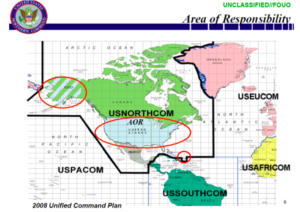
NORTHCOM AOR
“We still approach problems regionally. We plan, strategize, and we manage forces regionally,” VanHerck told the Air Force Association’s winter meeting this past Friday. “We need to think about these problems globally.
“I think we’re still just too stovepiped with our data — data that’s not getting shared in a timely enough manner at the operational and strategic level to have influence, especially in the competition stage. … I need decision space for senior leaders, and options for the senior leaders, in competition, and more importantly, in crisis and conflict so that we can de-escalate, and if required to defeat,” he added.
GIDE Series
The upcoming exercise is the second in a planned series of Global Integration and Information Dominance events, that in part are designed to “complement a shift in focus from pure defeat mechanisms towards earlier deter and deny actions well left of the kinetic activity,” a NORTHCOM spokesperson said in an email.
The first was held in December, as a table-top exercise (TTX) conducted in “coordination with U.S. Southern Command, U.S. Indo-Pacific Command, U.S. Transportation Command, U.S. Strategic Command, and the Under Secretary of Defense for Intelligence and Security,” the spokesperson said. The TTX fed “historic signal intelligence, electronic intelligence, and satellite imagery” of “enemy” force movements to an AI algorithm, that “generated possible enemy course of actions and recommended proactive blue force response options.”
Nine of the 11 Combatant Commands (COCOMS) currently plan to participate in GIDE 2, Strohmeyer said. Further, it will be linked to a real-world US and Canadian exercise involving NORTHCOM, European Command (EUCOM) and Strategic Command (STRATCOM). “There will be several assets that are actually transitioning across Combatant Command lines during GIDE 2,” he added. “We want to make sure that we’re testing against real things that are out in the world.”
NORTHCOM is hoping that a third GIDE experiment will involve all 11 COCOMS, and can take place sometime in the summer, Strohmeyer said, although he noted that this is still “pre-decisional.” The aim is to include more domains, all of the services and more live action, he said.
Each of the exercises is serving to test and improve the three AI tools developed so far in the process, each of which is at a different developmental stage, Strohmeyer explained. And each of the tools have slightly different jobs to do, he added.
Domain Awareness Tool
The first tool, that NORTHCOM has been using itself for about six months, is called Pathfinder. Pathfinder “takes raw radar feeds off of every military and FAA radar in North America, Canada, Alaska, Hawaii, and Guam,” he explained, and fuses the data to create a picture of adversary activities. Pathfinder was created “inside NORAD/NORTHCOM, the J6 specifically, working with several different vendors,” he said, as well as partners Air Force Research Laboratory, the Defense Innovation Unit, JAIC and the PEO Digital.
The GIDE 2 exercise will use that software to pull in live data from each one of NORTHCOM’s homeland defense airfields,” he explained. “We’re gonna have real threats that we’re representing via bombers, and when those threats are actually flying against North America, the system is going to be recommending the best course of action to launch fighters or other assets to that threat.”
The key here is that the AI system — not a slow human as in the past — will rapidly provide and constantly upgrade best options to ensure a high probability of intercept, the time each solution would take, and the best asset to pair to each — thus increasing options and decision time to chose among them. “The human now can have more time and more options to be able to make a decision,” Strohmeyer explained.
Information Dominance Tool
The second AI system builds from the first, but is bringing together an expanded set of data, Strohmeyer said. It, too, has been deployed to NORTHCOM’s C2 centers. “We’re trying it right now in real-world scenarios,” he said.
The prototype system is working towards being “able to see all domains from subsurface to geosynchronous orbit, bringing in both Blue Force, and Red Force feeds and views,” he explained. Space data is one critical input, he noted, with imagery gathered from military, Intelligence Community and commercial satellites. Signals intelligence and electronic intelligence data also are being used, the NORTHCOM spokesperson noted.
For this reason, Strohmeyer noted, NORTHCOM is working closely with the National Geospatial-Intelligence Agency (NGA). NGA and the National Reconnaissance Office (NRO) have been working to augment imagery and analysis gleaned from national security satellites with commercial data, backed strongly by the Senate. NGA further has been concentrating on use of AI/machine learning to speed its own analysis and improve the products it provides to government customers.
Rather than focusing on real-time object tracking (which is what radar do), this AI tool is aimed a providing commanders “an earlier and better understanding about what competitors are doing,” Strohmeyer said. “With these tools, we seek to gain earlier understanding of competitor intentions, increasing our decision space and the number of options available in competition and crisis. … “So, if you can think about how we’re trying to move left in our in our ability to see what competitors are doing, this tool allows us to be able to see: what are the competitors doing on a day-to-day basis, at their airfields, at their command and control facilities, at the places that they would be operating from for their maritime operations.”
The goal, he said, is to make adversaries think twice before taking an unwanted action early in the game, during the ‘competition phase’ of the conflict spectrum — “so, if they start going down a path that would be detrimental to the US and our allies and partners, that we can take an action.”
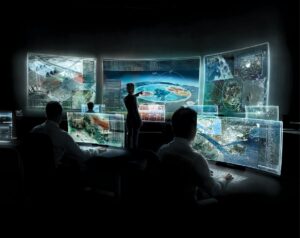
JADC2, Lockheed Martin image
Cross-Command Collaboration Tool
This software system essentially creates a virtual battlefield picture in 3D from all the data gathered by the first two AI tools, Strohmeyer said, and provides pop up alerts when an adversary does something of potential interest or there is “a change in the competitor’s pattern of life.” (Real-time ‘change detection’ is one of the holy grails for the IC in analyzing imagery, geolocation and other sensor data.)
The goal is two-fold: 1) to provide commanders both with an understanding of what competitors are doing not just in their formal area of operations (AOR) but around the globe; and 2) to provide a collaborative environment where commanders are all looking at the same picture and can work together to decide how to respond.
The tool is still in a prototype phase, he said, being incrementally improved as it is used in various demonstrations. Indeed, it was first deployed in a very early form during the Air Force’s second ‘onramp’ experiment in September of technology being developed under the Advanced Battle Management System (ABMS). It was refined and used again in GIDE 1, refined again and now will be used in GIDE 2.
Cooperation Efforts
The testing of the NORTHCOM tool during the ABMS experiment is an example of how the command is trying to work with the various other DoD and Joint Staff efforts to implement JADC2, officials said although the GIDE exercises are not directly tied to those initiatives or even to the development of the JADC2 strategy by the Joint Staff.
“There is no formal relationship between the GIDE events and the Globally Integrated Exercises, ABMS, Project Overmatch, Project Convergence, or JADC2,” the NORTHCOM spokesperson said. However, “NORTHCOM is working closely with several service-level and Joint Staff agencies to develop these capabilities and to ensure they remain closely tied with emerging joint concepts like JADC2 and the Joint Warfighting Concept.”
